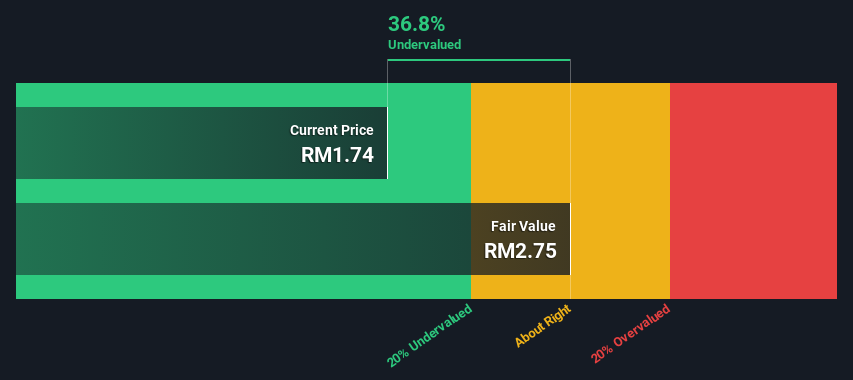- Malaysia
- /
- Healthcare Services
- /
- KLSE:KPJ
KPJ Healthcare Berhad (KLSE:KPJ) Shares Could Be 37% Below Their Intrinsic Value Estimate

Key Insights
- KPJ Healthcare Berhad's estimated fair value is RM2.75 based on 2 Stage Free Cash Flow to Equity
- Current share price of RM1.74 suggests KPJ Healthcare Berhad is potentially 37% undervalued
- Analyst price target for KPJ is RM1.76 which is 36% below our fair value estimate
How far off is KPJ Healthcare Berhad (KLSE:KPJ) from its intrinsic value? Using the most recent financial data, we'll take a look at whether the stock is fairly priced by taking the expected future cash flows and discounting them to today's value. Our analysis will employ the Discounted Cash Flow (DCF) model. There's really not all that much to it, even though it might appear quite complex.
Remember though, that there are many ways to estimate a company's value, and a DCF is just one method. Anyone interested in learning a bit more about intrinsic value should have a read of the Simply Wall St analysis model.
View our latest analysis for KPJ Healthcare Berhad
The Calculation
We're using the 2-stage growth model, which simply means we take in account two stages of company's growth. In the initial period the company may have a higher growth rate and the second stage is usually assumed to have a stable growth rate. To start off with, we need to estimate the next ten years of cash flows. Where possible we use analyst estimates, but when these aren't available we extrapolate the previous free cash flow (FCF) from the last estimate or reported value. We assume companies with shrinking free cash flow will slow their rate of shrinkage, and that companies with growing free cash flow will see their growth rate slow, over this period. We do this to reflect that growth tends to slow more in the early years than it does in later years.
A DCF is all about the idea that a dollar in the future is less valuable than a dollar today, so we need to discount the sum of these future cash flows to arrive at a present value estimate:
10-year free cash flow (FCF) forecast
| 2024 | 2025 | 2026 | 2027 | 2028 | 2029 | 2030 | 2031 | 2032 | 2033 | |
| Levered FCF (MYR, Millions) | RM427.1m | RM464.8m | RM572.0m | RM704.0m | RM738.0m | RM768.2m | RM798.4m | RM828.8m | RM859.7m | RM891.3m |
| Growth Rate Estimate Source | Analyst x6 | Analyst x6 | Analyst x3 | Analyst x1 | Analyst x1 | Est @ 4.09% | Est @ 3.93% | Est @ 3.81% | Est @ 3.73% | Est @ 3.67% |
| Present Value (MYR, Millions) Discounted @ 8.7% | RM393 | RM393 | RM445 | RM504 | RM485 | RM465 | RM444 | RM424 | RM404 | RM386 |
("Est" = FCF growth rate estimated by Simply Wall St)
Present Value of 10-year Cash Flow (PVCF) = RM4.3b
The second stage is also known as Terminal Value, this is the business's cash flow after the first stage. The Gordon Growth formula is used to calculate Terminal Value at a future annual growth rate equal to the 5-year average of the 10-year government bond yield of 3.5%. We discount the terminal cash flows to today's value at a cost of equity of 8.7%.
Terminal Value (TV)= FCF2033 × (1 + g) ÷ (r – g) = RM891m× (1 + 3.5%) ÷ (8.7%– 3.5%) = RM18b
Present Value of Terminal Value (PVTV)= TV / (1 + r)10= RM18b÷ ( 1 + 8.7%)10= RM7.7b
The total value, or equity value, is then the sum of the present value of the future cash flows, which in this case is RM12b. To get the intrinsic value per share, we divide this by the total number of shares outstanding. Compared to the current share price of RM1.7, the company appears quite good value at a 37% discount to where the stock price trades currently. Remember though, that this is just an approximate valuation, and like any complex formula - garbage in, garbage out.

Important Assumptions
We would point out that the most important inputs to a discounted cash flow are the discount rate and of course the actual cash flows. If you don't agree with these result, have a go at the calculation yourself and play with the assumptions. The DCF also does not consider the possible cyclicality of an industry, or a company's future capital requirements, so it does not give a full picture of a company's potential performance. Given that we are looking at KPJ Healthcare Berhad as potential shareholders, the cost of equity is used as the discount rate, rather than the cost of capital (or weighted average cost of capital, WACC) which accounts for debt. In this calculation we've used 8.7%, which is based on a levered beta of 0.819. Beta is a measure of a stock's volatility, compared to the market as a whole. We get our beta from the industry average beta of globally comparable companies, with an imposed limit between 0.8 and 2.0, which is a reasonable range for a stable business.
SWOT Analysis for KPJ Healthcare Berhad
- Earnings growth over the past year exceeded the industry.
- Debt is well covered by cash flow.
- Dividends are covered by earnings and cash flows.
- Interest payments on debt are not well covered.
- Dividend is low compared to the top 25% of dividend payers in the Healthcare market.
- Annual revenue is forecast to grow faster than the Malaysian market.
- Trading below our estimate of fair value by more than 20%.
- Annual earnings are forecast to grow slower than the Malaysian market.
Next Steps:
Although the valuation of a company is important, it ideally won't be the sole piece of analysis you scrutinize for a company. DCF models are not the be-all and end-all of investment valuation. Preferably you'd apply different cases and assumptions and see how they would impact the company's valuation. If a company grows at a different rate, or if its cost of equity or risk free rate changes sharply, the output can look very different. Can we work out why the company is trading at a discount to intrinsic value? For KPJ Healthcare Berhad, there are three relevant elements you should further examine:
- Risks: Case in point, we've spotted 1 warning sign for KPJ Healthcare Berhad you should be aware of.
- Future Earnings: How does KPJ's growth rate compare to its peers and the wider market? Dig deeper into the analyst consensus number for the upcoming years by interacting with our free analyst growth expectation chart.
- Other High Quality Alternatives: Do you like a good all-rounder? Explore our interactive list of high quality stocks to get an idea of what else is out there you may be missing!
PS. The Simply Wall St app conducts a discounted cash flow valuation for every stock on the KLSE every day. If you want to find the calculation for other stocks just search here.
Valuation is complex, but we're here to simplify it.
Discover if KPJ Healthcare Berhad might be undervalued or overvalued with our detailed analysis, featuring fair value estimates, potential risks, dividends, insider trades, and its financial condition.
Access Free AnalysisHave feedback on this article? Concerned about the content? Get in touch with us directly. Alternatively, email editorial-team (at) simplywallst.com.
This article by Simply Wall St is general in nature. We provide commentary based on historical data and analyst forecasts only using an unbiased methodology and our articles are not intended to be financial advice. It does not constitute a recommendation to buy or sell any stock, and does not take account of your objectives, or your financial situation. We aim to bring you long-term focused analysis driven by fundamental data. Note that our analysis may not factor in the latest price-sensitive company announcements or qualitative material. Simply Wall St has no position in any stocks mentioned.
About KLSE:KPJ
KPJ Healthcare Berhad
An investment holding company, engages in the operation of specialist hospitals in Malaysia, Thailand, and Bangladesh.
Excellent balance sheet with proven track record.
Similar Companies
Market Insights
Community Narratives



